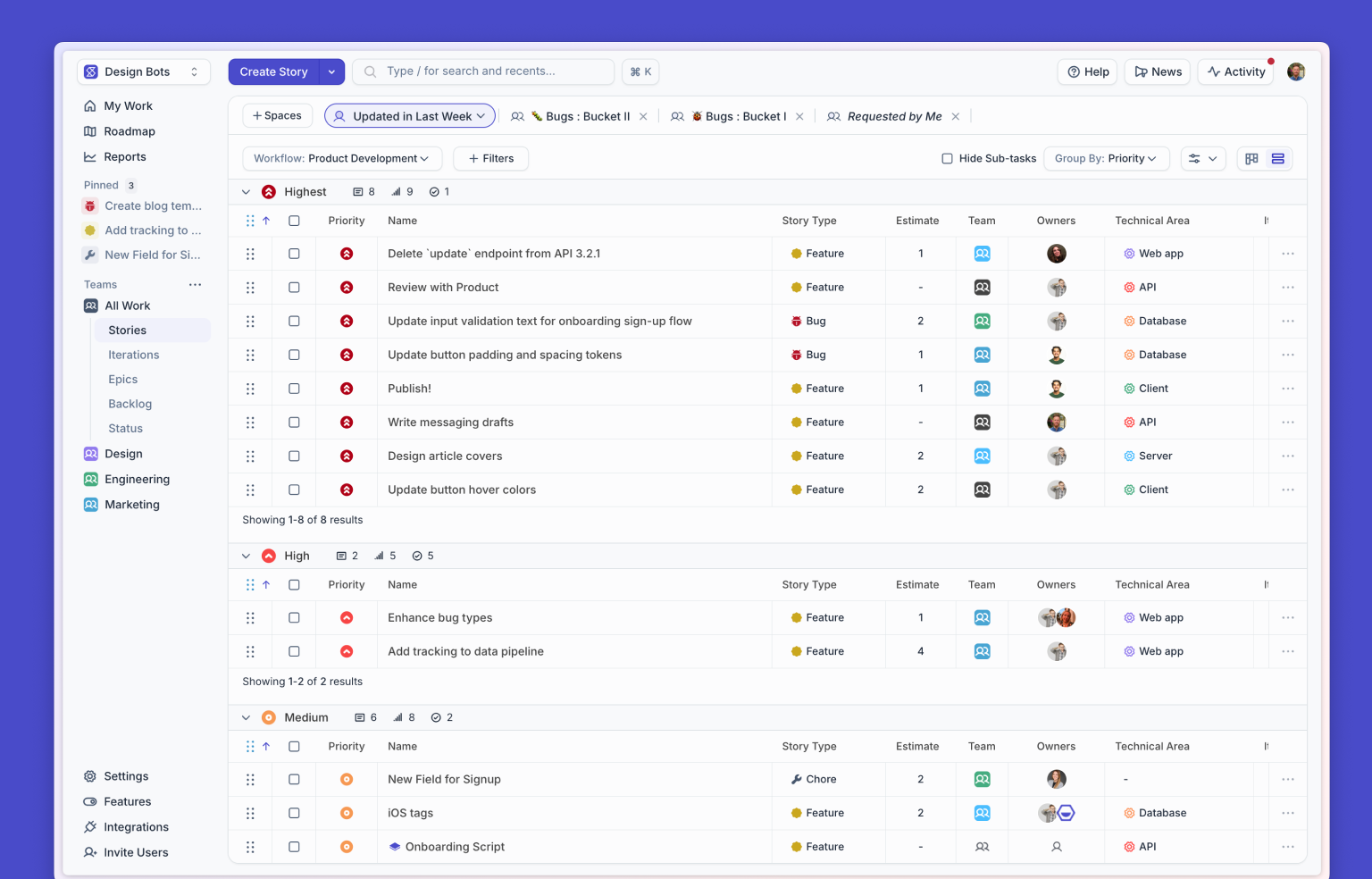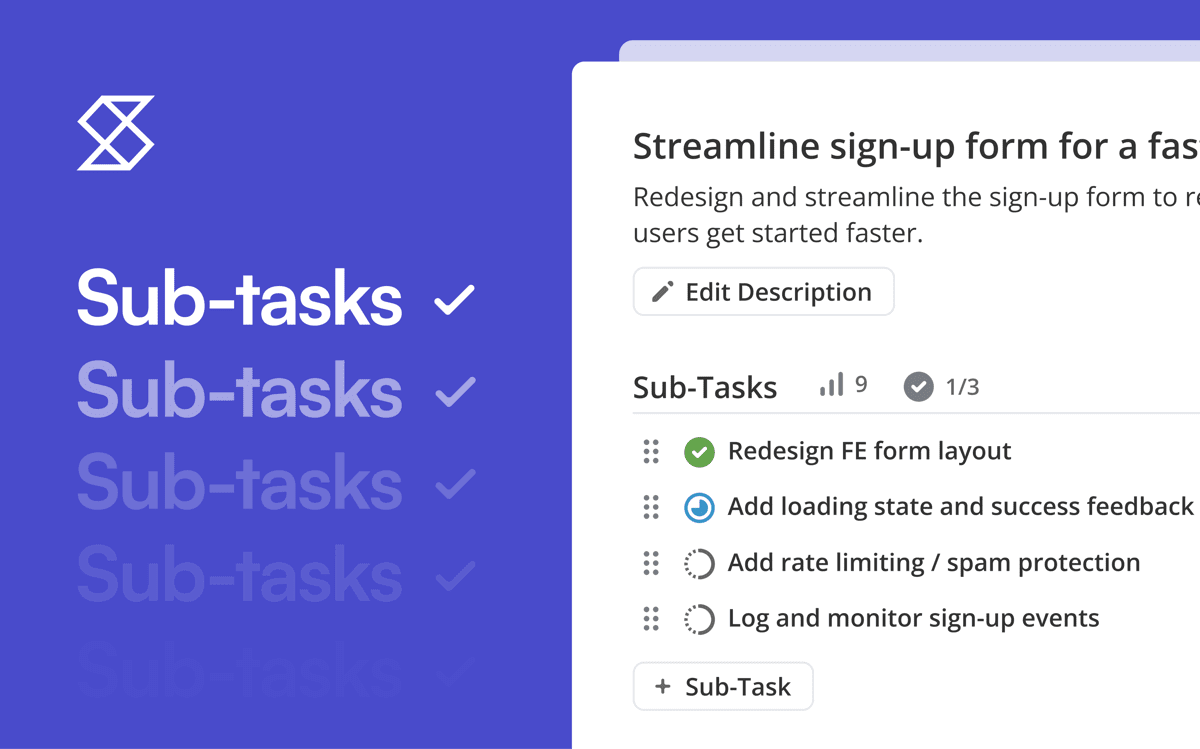Engineering teams are building faster than ever, balancing complex projects, tight deadlines, and cross-functional collaboration. The tools they use to plan, track, and ship work can make the difference between smooth delivery and endless status updates.
In 2026, the best project management tools are the ones that blend speed, structure, and visibility. They help engineers stay focused, keep product managers aligned, and make progress visible without adding overhead.
We’ve reviewed the top tools engineering teams are using this year based on features, usability, reporting, integrations, and developer experience. Whether you’re a fast-moving startup or a growing engineering org, here are the top picks to consider.
TL;DR
- Shortcut: Best all-around for software teams that need speed, structure, and flexibility
- Jira: Best for enterprise workflows and compliance needs
- Linear: Best for speed and design-driven teams
- Trello: Best for simple visual task management
- ClickUp: Best for all-in-one customization
- Monday.com: Best for cross-department visibility
1. Shortcut — Best All-Around for Software Teams
Shortcut is a modern project management platform built specifically for engineering and product teams. It combines agile sprint planning, story tracking, epics, and roadmaps in one clean, fast interface.
Unlike general project tools, Shortcut speaks the language of software teams, connecting planning, coding, and reporting in a single workflow. Its direct GitHub integration keeps branches and commits linked to stories automatically, so engineers can stay focused while PMs get real-time visibility.
Why teams love it:
- Fast and intuitive with minimal setup
- Supports sprints, roadmaps, and objectives out of the box
- Real-time GitHub integration connects code and planning
- Custom fields and flexible workflows for different teams
- Built-in reports for velocity, cycle time, and progress tracking
Best for: Engineering teams that want a lightweight but complete system that scales without slowing them down.
2. Jira — Best for Enterprise Workflows
Jira remains a staple for large enterprises with complex governance or compliance needs. It offers deep configuration, custom permissions, and integrations with the Atlassian suite (Confluence, Bitbucket, Opsgenie).
For organizations that require audit trails, advanced reporting, or strict process controls, Jira’s feature set is unmatched. But that flexibility comes at a cost: setup and maintenance often require dedicated admins.
Why teams use it:
- Handles complex hierarchies and permissions
- Rich marketplace of plug-ins and integrations
- Detailed reporting for compliance and enterprise tracking
Consider if: You need highly customizable workflows and have resources to manage configuration over time.
3. Linear — Best for Speed and Aesthetics
Linear delivers one of the fastest, most elegant experiences in issue tracking. Its clean design, keyboard-driven commands, and GitHub integration make it a favorite among developer-led teams that prioritize focus and momentum.
Linear structures work through Issues, Projects, and Initiatives, with Cycles that function like sprints and Insights for measuring progress. Its opinionated design keeps workflows simple, but customization options (like custom fields or advanced reporting) are intentionally limited.
Strengths:
- Sleek, responsive interface and minimal learning curve
- Keyboard-first commands make it fast to navigate
- Native GitHub and GitLab integrations
- Built-in Cycles, Projects, and Insights for agile tracking
Limitations:
- Less flexibility for teams needing custom workflows or fields
- Reporting and hierarchy options are narrower than in Shortcut
Best for: Teams that want a fast, polished issue tracker optimized for engineers.
4. Trello — Best for Visual Simplicity
Trello popularized the card-and-board view for task management. It’s easy to adopt, visually intuitive, and works well for small teams or projects that don’t require heavy process.
While Trello can be extended with Power-Ups (its add-on ecosystem), engineering teams often outgrow it when they need advanced features like sprint metrics, roadmaps, or GitHub syncing.
Pros:
- Simple and visual Kanban interface
- Quick to onboard and collaborate
- Generous free tier
Cons:
- Limited reporting and automation for agile workflows
- Not ideal for technical or multi-team projects
Best for: Small or non-technical teams managing straightforward projects.
5. ClickUp — Best for All-in-One Customization
ClickUp aims to be an all-in-one workspace combining tasks, docs, goals, and chat. It’s highly customizable since every field, view, and automation can be tailored to your workflow.
That flexibility makes it powerful, but also complex. For engineering teams, it can feel heavy compared to focused tools like Shortcut or Linear.
Pros:
- Extremely configurable with custom views and automations
- Suitable for managing cross-functional teams
- Includes docs, dashboards, and goals in one place
Watch out for:
- Steeper learning curve
- Some engineering-specific features require setup or third-party integrations
Best for: Teams that want a central hub for all work, not just software development.
6. Monday.com — Best for Cross-Department Collaboration
Monday.com offers broad appeal across marketing, operations, and product teams. Its colorful interface and flexible views make it easy to visualize progress and align multiple departments.
For engineering teams, it works best when paired with integrations that bring in technical context, such as GitHub or Jira connectors. It’s less of a development platform and more of a collaboration dashboard for everyone involved in a product’s lifecycle.
Why teams use it:
- Intuitive and visual interface
- Flexible reporting and dashboards
- Easy to align projects across teams
Consider if: You need a shared view across departments, but handle engineering details elsewhere.
How to Choose the Right Project Management Tool in 2026
The best project management tool for your engineering team depends on how you build software. Here are key factors to consider before committing:
Ease of use: The tool should be intuitive for developers, PMs, and stakeholders alike.
Developer integrations: Seamless GitHub or GitLab connections are essential for keeping planning and code linked.
Customization: Look for flexible workflows, custom fields, and reporting options that adapt to your process.
Scalability: Even small teams benefit from tools that support Objectives, Epics, and long-term planning.
Speed: A fast, lightweight interface keeps engineers in flow and reduces friction between planning and building.
Automation: AI features or integrations that eliminate manual updates can save hours of busywork.
Shortcut checks all these boxes, combining flexibility and reporting with the speed and simplicity developers expect.
Korey — AI Project Management for Faster Work
Korey is an AI project management agent from Shortcut that integrates with both Shortcut and GitHub Issues. It helps teams handle the “work about work” by transforming ideas into structured, ready-to-build stories.
Teams use Korey to:
- Write specs, PRDs, and user stories automatically
- Break down work into sub-tasks
- Summarize progress and release notes
- Keep Shortcut and GitHub Issues aligned
Because Korey lives outside the tool itself, it centralizes AI support without adding clutter, keeping your workspace focused while speeding up delivery.
Conclusion
Project management tools continue to evolve, but the goal remains the same: keep engineering teams aligned, focused, and moving forward.
In 2026, Shortcut stands out for combining speed and flexibility, giving software teams everything they need to plan, collaborate, and deliver without slowing down.
Try Shortcut free and see how your team can build better, together.

















%20(788%20x%20492%20px)%20(1).png)
.png)

